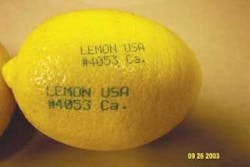Isn't a lime, it's a lemon
LaGrange, GE — We had some fun in the March issue with facetious comments about laser applications in the food industry, which prompted some amusing input from readers about other aborted applications, including the infamous cheese cutting one (see the ILS Web site). So with a little caution we interviewed Greg Drouillarg at Durand-Wayland who has developed and patented a process for laser marking produce.
Right up front let me set the record straight. Durand-Wayland, responding to a survey that suggested consumers might be turned-off by the words laser marking, implying, perhaps that the laser interfered with the natural state of the produce, prefers that the process be called "laser/controlled light." However, because the company's own press release refers to it as a laser coding, we will use the proper term.
It seems that about nine years ago, at an agricultural industry conference, the U.S. government's pending requirements for identifying single units of produce with a "country of origin" label prompted the development of an adhesive label carrying, for now, Product Look Up Codes (PLU) and eventually, when the Government gets around to it, Country of Origin Labeling (COOL). Other methods such as inkjet marking had legibility issues.
A list of problems associated with adhesive label identification should be obvious, even to those of us not in the produce business. Chief among these are first and foremost, permanence, at least until the user chooses to remove it. But for the produce packer issues such as adhesion are only one of many: label data capability, complexity of a labeling machine (with the attendant variability of labels for product type, size, quality, and producer), and label inventory to name a few.
So Drouillarg set out to develop a non-contact identification system and the laser was his first choice. It took nine years but at an April 14th introduction, Durand-Wayland showed its Produce Laser System, specifically designed to easily integrate into a packinghouse environment. This unit produces a permanent, legible identifying mark on the skin of fruit and vegetables without degrading the product quality or flavor. It works by removal of some of the skin pigment by the absorbed 10.6µm light, leaving a contrasting colored mark.
It's done by a scanned beam CO2 laser (from Linx) that produces a dot matrix code on a single piece of produce, which is moved under the beam by a chain containing cups to hold the product. Marking at a rate of 14 units per second surpasses the chain's speed of 8-10 units/second. In a packinghouse it might be necessary to have anywhere from 1 to 40 chains depending on produce volumes. Each chain line requires a laser marking head.
The obvious advantages of non-contact laser marking are well known but for the produce packing market it also means instant PLU changeover, elimination of high-cost adhesive labels, no waste and low energy costs, environmental and health compatibility, traceability, information storage, no consumables, no additional personnel required, and the ability to do COOL when it is finally required.
In our opinion the produce marker may well be that killer application in the food industry we joked about in the March issue. For more on the Durand-Wayland system contact Kay Durand, [email protected].—DAB

